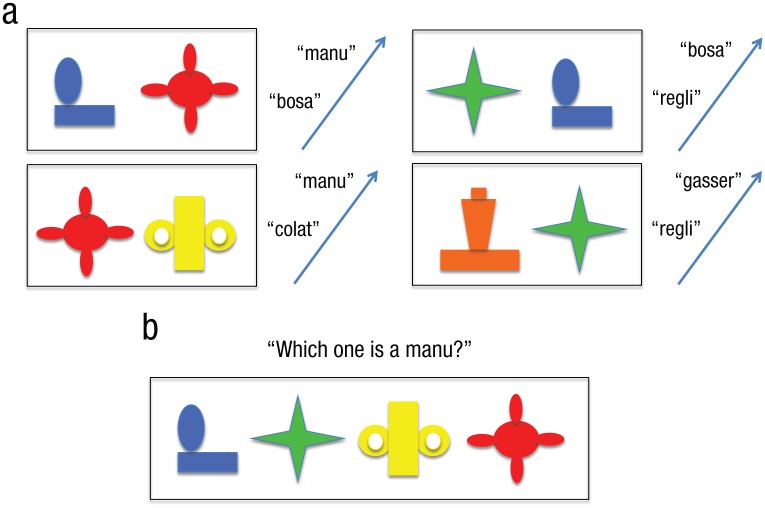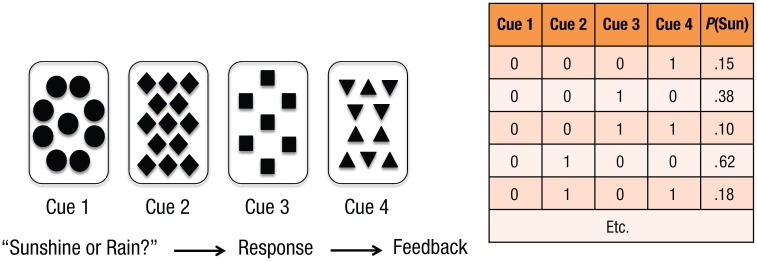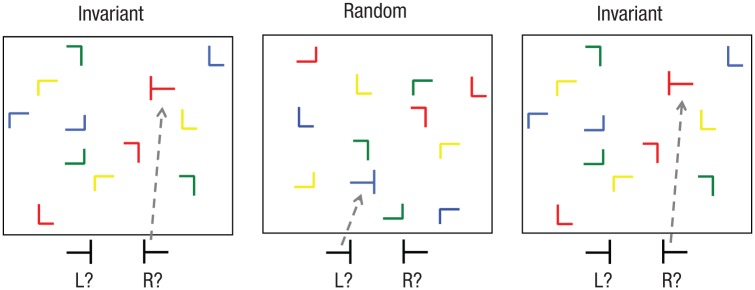Abstract
Statistical learning plays an important role in the acquisition of spoken and written language. It has been proposed that impaired or atypical statistical learning may be linked with language difficulties in developmental disabilities. However, research on statistical learning in individuals with developmental disabilities such as autism spectrum disorder, dyslexia, and specific language impairment, and in individuals with cochlear implants, has produced divergent findings. It is unclear whether, and to what extent, statistical learning is impaired or atypical in each of these developmental disabilities. We suggest that these disparate findings point to several critical issues that must be addressed before we can evaluate the role of statistical learning in atypical child development. While the issues we outline are interrelated, we propose four key points relating to (a) the nature of statistical learning, (b) the myriad of ways in which statistical learning can be measured, (c) our lack of understanding regarding the developmental trajectory of statistical learning, and (d) the role of individual differences. We close by making suggestions that we believe will be helpful in moving the field forward and creating new synergies among researchers, clinicians, and educators to better support language learners.
Keywords: statistical learning, developmental disabilities, language acquisition, dyslexia, specific language impairment, autism spectrum disorder, hearing impairment
Statistical learning is broadly defined as the ability to detect regularities and is closely linked with the constructs of implicit learning and procedural learning. More specifically, statistical learning is often described as detection of probabilistic relations, but the field has yet to reach a consensus on a precise definition. Statistical learning likely plays an important role in the acquisition of spoken and written language (e.g., Arciuli & Torkildsen, 2012; Aslin & Newport, 2014; Erickson & Thiessen, 2015). Thus, there is great interest in whether statistical learning is atypical in developmental disabilities associated with language difficulties, including autism spectrum disorder (ASD; e.g., Jeste et al., 2015; Scott-Van Zealand et al., 2010), specific language impairment (e.g., Lum, Conti-Ramsden, Morgan, & Ullman, 2014; Obeid, Brooks, Powers, Gillespie-Lynch, & Lum, 2016), dyslexia (e.g., Gabay, Thiessen, & Holt, 2015; Sigurdardottir et al., 2017), and hearing impairment (e.g., Conway, Pisoni, Anaya, Karpicke, & Henning, 2011; Pisoni, Kronenberger, Chandramouli, & Conway, 2016). These investigations promise a more nuanced understanding of developmental disabilities, with dramatic implications for the way language difficulties in these developmental disabilities are assessed and remediated.
Despite this promise, research findings are mixed. It is unclear whether, and to what extent, statistical learning is atypical in each of these disabilities. For example, in their meta-analysis of studies using tasks that measure serial reaction time (SRT), Lum, Ullman, and Conti-Ramsden (2013) found evidence of a link between impaired statistical learning and dyslexia. This link may be more complex than previously thought because age appears to interact with methodological characteristics of tasks measuring statistical learning in a way that impacts effect sizes. For instance, differences in statistical learning between dyslexic and control groups were smaller in older participants who received more exposure to regularities during experiments. A meta-analysis of studies on artificial grammar learning (AGL) in dyslexia drew a similar conclusion about age-related effects but raised questions about publication bias favoring articles reporting significant differences in statistical learning between dyslexic and nondyslexic groups (Witteloostuijn, Boersma, Wijnen, & Rispens, 2017). Divergent findings have also emerged in research on statistical learning in specific language impairment (or developmental language disorder), ASD, and hearing impairment.
Although there are some comorbidities, it is generally agreed that the nature of language impairment differs across these disabilities. Moreover, there is variability in the severity of language difficulties within these disabilities. It is unclear how atypical statistical learning plays a role in different types of language difficulties and in the severity of these difficulties. Here, we highlight several critical issues that must be addressed in order to refine our understanding of statistical learning, deepen our knowledge of developmental disabilities and the language difficulties associated with them, and pave the way for translational research to support struggling language learners. These issues are interrelated but, for ease of understanding, we propose four key points.
There Is a Lack of Consensus Regarding the Nature of Statistical Learning
It is argued that statistical learning is a ubiquitous feature of mental activity, but there is no consensus on even the most basic questions about statistical learning. Is statistical learning domain general, domain specific, or both? To what extent does statistical learning draw on top-down and bottom-up processes? Is statistical learning a single ability or a collection of abilities? Despite the provision of theoretical frameworks (e.g., Arciuli, 2017; Aslin & Newport, 2014; Daltrozzo & Conway, 2014; Frost, Armstrong, Siegelman, & Christiansen, 2015; P. J. Reber, 2013; Thiessen, Kronstein, & Hufnagle, 2013), there has been little effort to test these proposals. In line with the multicomponent view of statistical learning proposed by Arciuli (2017), statistical learning may consist of a variety of partially separable “components” relating to stimulus encoding, retention, and abstraction that work together to achieve learning. For the sake of simplicity, let us say that statistical learning involves four components (A, B, C, D). Some components (A, B) may be functioning atypically in certain individuals, but others (C, D) might be quite strong. This could result in a very different behavioral profile from that of someone with atypical functioning of other components (B, D). Identifying constituent components is paramount to understanding the nature of statistical learning and how it might be compromised in developmental disabilities in ways that can affect language differentially.
Neuroimaging methods can help us understand how constituent components are underpinned by particular brain regions and networks. For instance, Krishnan, Watkins, and Bishop (2016) reviewed evidence suggesting that specific language impairment is associated with abnormalities of the striatum, whereas other developmental disabilities might be associated with abnormalities in different brain regions. A possibility yet to be fully investigated is that patterns of connectivity among the brain regions that underpin statistical learning may differ across populations, and across individuals within populations, in ways that impact language differentially.
There Are Many Different Ways to Measure Statistical Learning
The most commonly used tasks involve triplet or word segmentation (Saffran, Aslin, & Newport, 1996), visual scene base pairs (Fiser & Aslin, 2001), AGL (A. S. Reber, 1967), SRT (Nissen & Bullemer, 1987), Hebb repetition (Hebb, 1961), or scenarios relating to weather prediction (Knowlton, Squire, & Gluck, 1994), contextual cuing (Chun & Jiang, 1998), or cross-situational learning (Yu & Smith, 2007). Figures 1 through 8 show examples of tasks used to measure statistical learning and implicit learning. Although there are commonalities across tasks (e.g., many rely on detection of probabilistic relations), there are some clear differences (e.g., regarding detection of regularities relating to temporal order, spatial locations, or identity mapping, and the role of passive exposure vs. active participation during familiarization). In addition to differences across tasks, each task can be modified in a multitude of ways, for example, in terms of instructions to participants that can affect the implicit nature of the task (instructions to remember or follow patterns vs. no instructions to remember or learn anything) and in terms of the inputs used, which can alter key demands of the task (visual vs. auditory stimuli, linguistic vs. nonlinguistic stimuli, embedding of adjacent vs. nonadjacent regularities, slow vs. fast stimulus presentation times, few vs. many repetitions of regularities). Schiff and Katan’s (2014) meta-analysis of 10 different grammars used in 56 AGL studies elegantly demonstrates how manipulation of a single task parameter, in this case complexity, as measured by topological entropy, can affect performance. To complicate matters further, there are many ways that learning can be measured using these tasks (during learning, immediately after learning, or after a significant delay; in ways that reflect extraction vs. generalization; in ways that draw on vs. do not draw on motor responding; in ways that draw on vs. do not draw on explicit judgments).
Fig. 1.
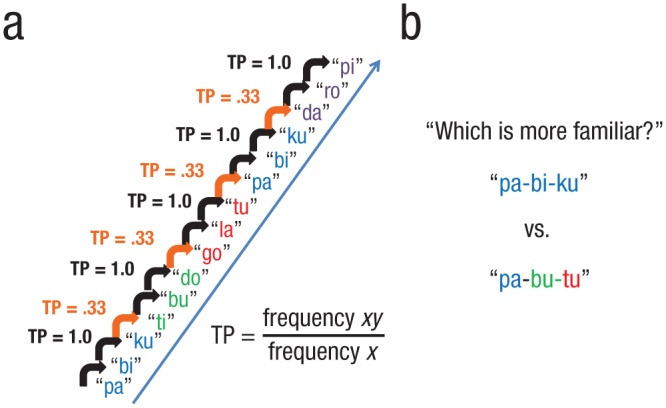
Triplet task (Saffran, Aslin, & Newport, 1996). In the familiarization phase, a portion of which is shown here (a), participants are given passive exposure to a continuous sequence of individually presented stimuli that co-occur to form triplets. There are differences in the transitional probability (TP) of stimuli within versus across triplet boundaries (e.g., TP = 1.0 vs. TP = .33). The formula for TP is provided, which gives the conditional probability of a given item (y) occurring following the occurrence of (x).The subsequent test phase (b) is comprised of two-alternative forced-choice trials requiring participants to judge which of two sets of triplets is familiar. On each trial, one triplet is consistent with the co-occurring stimuli presented during the familiarization phase, whereas the other is a foil triplet. In the figure, colors are used to illustrate which syllables are part of which triplets. This task is sometimes referred to as word segmentation or speech segmentation because the original task utilized spoken (nonsense) syllables.
Fig. 8.
Task assessing cross-situational learning (Yu & Smith, 2007). During the familiarization phase (a), participants are instructed to learn which labels or “words” go with which pictures. On each trial, visual referents are presented along with the same number of auditorily presented labels (in random order), with each label corresponding to one of the referents. In this example, the “manu” is the red object, the “bosa” is the blue object, the “colat” is the yellow object, the “regli” is the green object, and the “gasser” is the orange object. Following familiarization, participants are given a forced-choice test (b), in which they hear a label and must pick the visual referent that is associated with it.
Fig. 2.
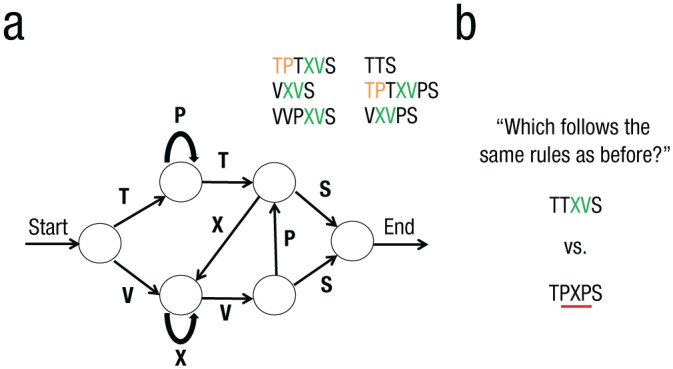
Task assessing artificial grammar learning (Reber, 1967). A sample artificial grammar is shown in (a). The grammar (which is never directly observed by participants) dictates the order in which particular stimuli (in this case, letters) can occur in a sequence. To generate a sequence, one traces a path through the grammar, starting on the left and following the arrows. As a letter is encountered along the path, it is recorded as the next letter in the sequence. This is done until arriving at the “end.” Sample sequences of letters generated from this grammar are shown. In the exposure phase of the task, participants are exposed to sequences of stimuli generated from the artificial grammar. Following exposure, participants engage in a test phase (b) in which they make grammaticality judgments on novel sequences that either adhere to or violate the grammar. In the figure, letters are colored to illustrate how the rules of the grammar result in certain combinations of frequently occurring letter pairs or triplets. The red line signifies letter combinations that are inconsistent with the grammar and thus are ungrammatical.
Fig. 3.
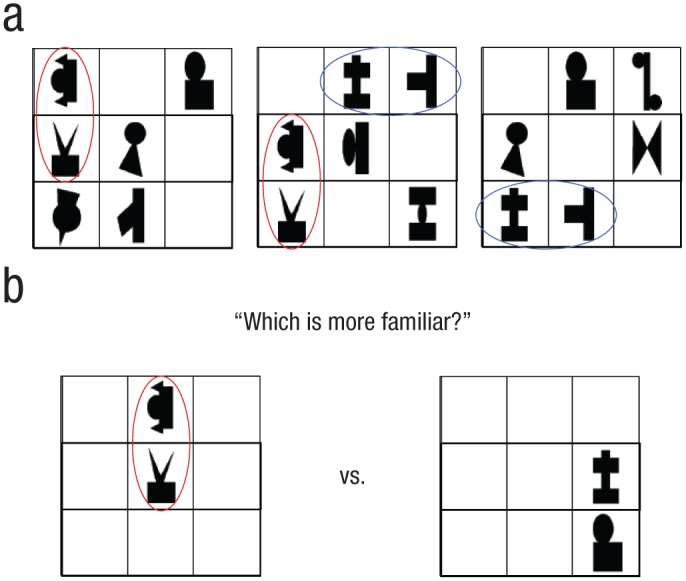
Visual scene (“base-pairs”) task (Fiser & Aslin, 2001). A familiarization phase (a) provides passive exposure to pairs of shape stimuli that are arranged on grids presented one at a time. Colored circles do not appear in the familiarization phase but are used here to illustrate how certain combinations of shapes (i.e., base pairs) co-occur frequently across different grids (note that some but not all regularities are circled in this graphic). The subsequent test phase (b) is comprised of two-alternative forced-choice trials requiring participants to judge which of two pairs is familiar. On each trial, one pair is consistent with the pairings from the familiarization phase (i.e., is a base-pair), whereas the other is a foil pair (note that circles do not appear in the test phase).
Fig. 4.
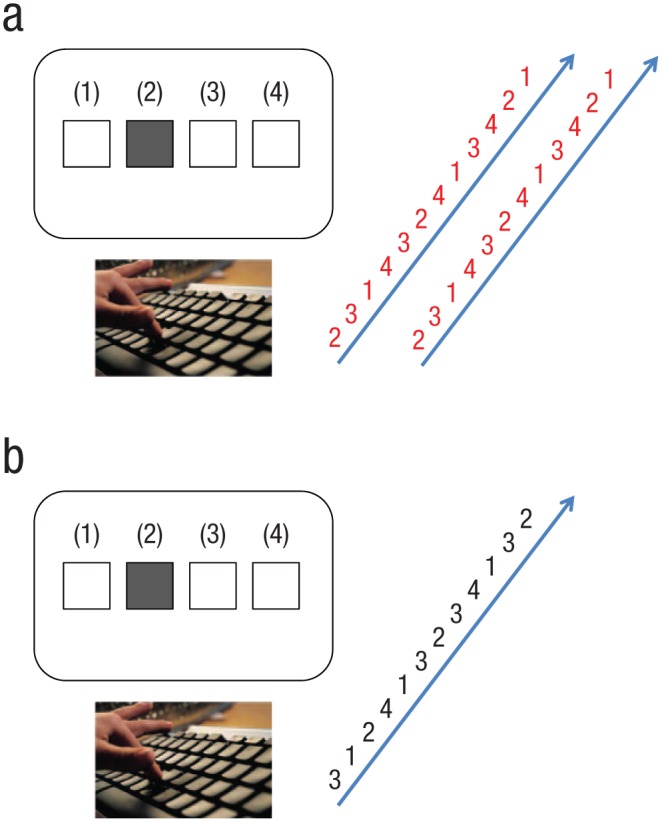
Task assessing serial reaction time (Nissen & Bullemer, 1987). In the first several blocks of trials (a), participants view a stimulus occurring in one of four locations, one at a time, in a specific repeating sequence (in this case, the 12-item sequence, 2-3-1-4-3-2-4-1-3-4-2-1; note that each number corresponds to a particular location on the screen—one of four locations). On each trial, participants are instructed to press a button corresponding to that particular location (one of four different buttons) as quickly as possible. On a subsequent block of trials (b), the stimuli occur in random order. Learning is assessed by comparing reaction times to the repeating sequence with reaction times to stimuli that appear in random order.
Fig. 5.
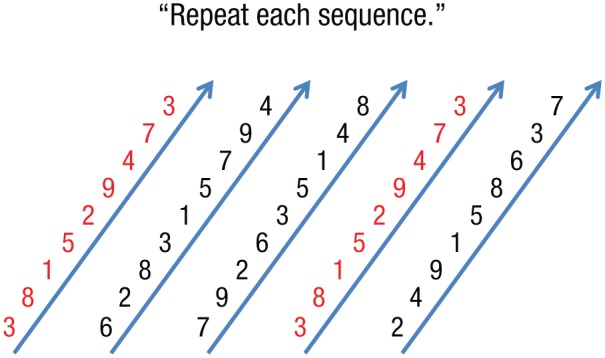
Hebb repetition task (Hebb, 1961). Participants view several sequences of stimuli and must repeat back each sequence in the correct order after it ends. On some trials, the sequence is random, and on other trials, the sequence is a repetition from a previous sequence (indicated here in red). Learning is assessed by comparing serial recall accuracy for the repeating sequence with accuracy for the random sequences.
Fig. 6.
Task assessing probabilistic weather prediction (Knowlton, Squire, & Gluck, 1994). On each trial, participants view between one and four visual cues and must predict a binary outcome (“sunshine” or “rain”). After they make their response, feedback is given as to whether their choice was correct or not, and then the next trial occurs. Each combination of visual cues has a particular probability associated with it relating to the weather outcome. The chart on the right shows the probability of sunshine or rain for five example combinations of cues (1 = present, 0 = absent).
Fig. 7.
Task assessing contextual cuing (Chun & Jiang, 1998). On each trial, participants view a scene with differently colored visual stimuli arranged on the screen and must press one of two buttons as quickly as possible to indicate whether a target stimulus (in each of these cases, a “T” on its side) is pointed to the left (L) or right (R). On some trials, the background stimuli occur in the same invariant arrangement, and on other trials, the background stimuli are presented in random arrangements. Learning is assessed by faster responses to targets in the invariant scenes than to targets in the random scenes.
Researchers tend to utilize one or only a small subset of these tasks. There has been little investigation of how these tasks relate to the broader construct of statistical learning and whether individuals might be expected to perform similarly on these tasks. We propose that different tasks (and different variations of a given task) may lead to different behavioral outcomes depending on how they draw on particular underlying components of statistical learning. Thus, any given disability associated with language difficulties may be linked with atypical statistical learning on certain tasks but not others. Henderson and Warmington (2017) found that adults with dyslexia showed equivalent performance on the SRT task but atypical learning on the Hebb repetition task. Conway et al. (2011) observed that children with cochlear implants were impaired on a visual sequence learning task involving an artificial grammar. By contrast, Torkildsen, Arciuli, Haukedal, and Wie (2018) observed no such impairment using a visual version of the classic triplet learning task—statistical learning was intact and equivalent in children with cochlear implants and in controls. These discrepant findings may result from differences in task characteristics relating to attentional demands, the nature of instructions or provision of feedback, familiarity and verbalizability of stimuli, the complexity of the regularities to be learned, and so on—characteristics that may interact with certain disabilities. Systematic assessment of various populations using a range of tasks designed to measure statistical learning may achieve a more complete understanding of how statistical learning is associated with developmental disabilities.
We note growing interest in the reliability of statistical-learning tasks (Kaufman et al., 2010; Siegelman, Bogaerts, Elazar, Arciuli, & Frost, 2018; Siegelman & Frost, 2015). In discussing assessment of cognition, rather than statistical learning per se, Hedge, Powell, and Sumner (2018) pointed out that reliability is conceptualized differently depending on the research objective (e.g., experimental vs. correlational research). Further, some forms of reliability that are not of concern when examining group-level effects (e.g., distinguishing impaired from unimpaired populations) are important when examining individual differences, and vice versa. It may be that for some tasks measuring statistical learning, these forms of reliability are at odds with one another when pursuing different research objectives. More research is needed on this and other reliability issues. Regarding internal consistency, some tasks that measure statistical learning are designed to reflect changes in performance during the test phase rather than consistent performance, possibly rendering some methods of determining split-half reliability inappropriate (e.g., the first vs. second half of test items might reflect change rather than consistency). There are also critical questions about the stability of statistical learning. Might developmental disabilities impact the stability of statistical learning within individuals in a way that affects test-retest reliability? There is limited value in pursuing psychometric evaluations of tasks measuring statistical learning without a deeper understanding of the nature of statistical learning.
We Lack a Comprehensive Understanding of the Developmental Trajectory of Statistical Learning
To understand statistical learning in atypical development, we must have a good understanding of its role in typical development. There are a number of studies that we could cite here, but because of length constraints, we will mention only a handful. While there is agreement that statistical learning is present from a very young age, basic questions remain about whether statistical learning is age invariant (e.g., Jost, Conway, Purdy, Walk, & Hendricks, 2015) or follows a gradual developmental progression (e.g., Thomas et al., 2004). To date, the largest study on age-related changes in statistical learning assessed 421 healthy participants between the ages of 4 and 85 years using the alternating SRT task, which allowed comparison between high-and low-probability sequences (Janacsek, Fiser, & Nemeth, 2012). Raw reaction time (RT) differences (differences between RTs for high- and low-probability sequences) showed that learning was uniform across ages until around 12 years, when there was a decrease, with learning then remaining uniform until around 60 years of age, when there was another decrease. When RT differences and accuracy differences were z transformed, they showed a different pattern of results, with growth in learning in the early years leading up to adolescence, followed by relative stability until around 45 years, when there was evidence of decline. A similar pattern of gradual developmental progression in childhood was identified earlier by Arciuli and Simpson (2011), who analyzed accuracy rates derived from a visual triplet task administered to 183 participants between the ages of 5 and 12 years. Raviv and Arnon (2018) replicated Arciuli and Simpson’s finding using a similar visual triplet task but found that performance on an auditory triplet task did not improve with age.
While these studies suggest that statistical learning may not be invariant over the life span, they also illustrate how different tasks, and different dependent variables from a single task, can result in different developmental trajectories. More research is needed to understand the developmental trajectory of statistical learning in typically developing individuals. This will provide benchmarks for understanding the link between statistical learning and developmental disabilities and help to delineate between deviance and delay.
There Is a Lack of Research Examining Individual Differences and Contextual Factors in Statistical Learning Within Developmental Disabilities
Most research on statistical learning in developmental disabilities has focused on group-level differences (e.g., comparing impaired with unimpaired groups); few studies have examined individual differences within a particular disability. An exception is the study by Gabay et al. (2015), which reported impaired statistical learning in a group of dyslexics relative to a control group as well as a link between individual differences in the capacity for statistical learning and reading performance within each group. Similarly, Conway et al. (2011) reported a link between the capacity for statistical learning and language proficiency in deaf children with cochlear implants. It is unclear how the aforementioned reliability issues play out in studies in which a single task is used to determine both group differences and individual differences.
A recent meta-analysis by Obeid et al. (2016) found little evidence of atypical statistical learning in ASD in studies that utilized group comparisons. However, the studies included in that meta-analysis recruited older children (> 11 years of age), adults, or both, and almost all included high-functioning individuals. It may be that individual differences would be found in studies that sampled the population more broadly (e.g., by including younger and older children as well as lower functioning and higher functioning children).
Other ASD-related factors that vary among individuals and may interact with statistical learning were summarized by Arciuli (2017). For instance, processing of social cues is compromised in individuals with ASD—such cues may guide statistical learning (e.g., Jeste et al., 2015, reported that individual differences in an electroencephalographic measure of statistical learning were associated with adaptive social function in children with ASD). Seldom have tasks measuring statistical learning been designed with demands on social processing built into the task itself. Even if individuals with ASD demonstrated performance in statistical learning equivalent to that of typically developing peers on these kinds of tasks in the laboratory, it may be that performance is quite different in ecologically valid settings where attention to social information is important for learning and likely to vary considerably among individuals.
Summary and Suggestions for Future Research
Addressing the issues noted above will lead to a more comprehensive understanding of statistical learning and how statistical learning is associated with language difficulties. We offer the following suggestions for future research endeavors:
First, rather than being a monolithic ability, statistical learning may reflect the complex interplay of multiple processes and networks. We need to understand how different tasks (and task parameters) assess these “components” of statistical learning—this may require development of new tasks to measure statistical learning and careful consideration of reliability issues. A battery of purpose-designed tasks measuring statistical learning will be helpful for determining whether the function (and dysfunction) of these components of statistical learning differs across populations and individuals within populations in ways that affect language differentially.
Second, elucidating the developmental trajectory of statistical learning is critical—this requires research that explores both typical and atypical development in cross-sectional and longitudinal studies so we can understand how different components of statistical learning change developmentally (or perhaps do not change in some populations and individuals).
Third, we should devise more detailed theories of how statistical learning relates to different aspects of spoken-, signed-, and written-language acquisition, including predictions that can be tested using a variety of approaches (e.g., behavioral, neurophysiological, computational) and across a variety of populations.
Fourth, research on statistical learning and language acquisition in developmental disabilities should be broadened beyond group comparisons to consideration of individual differences and contextual factors that contribute to variability in language difficulties within and across disabilities.
Fifth, we must move away from a sole focus on deficits to determining conditions under which individuals with developmental disabilities can and cannot learn statistical regularities (e.g., Evans, Saffran, & Robe-Torres, 2009; He & Tong, 2017; Schiff, Katan, Sasson, & Kahta, 2017). This is helpful for designing programs to support language learning by identifying relative strengths and weaknesses that might be targeted in various ways.
We have evaluated barriers preventing a full understanding of statistical learning and its role in language acquisition and suggested ways to move beyond them. The research endeavors we have suggested have the potential to transform assessment and remediation of language difficulties and create new synergies among researchers, clinicians, and educators to better support language learners.
Recommended Reading
Arciuli, J. (2017). (See References). Proposes a multicomponent view of statistical learning intended to better understand individual differences in language acquisition in typical and atypical child development.
Erickson, L., & Thiessen, E. D. (2015). (See References). Reviews theory and empirical findings specifying the role of statistical learning in typical and atypical language development.
Hasson, U. (2017). The neurobiology of uncertainty: Implications for statistical learning. Philosophical Transactions of the Royal Society B: Biological Sciences, 372(1711), Article 20160048. doi:10.1098/rstb.2016.0048. Discusses separate but ultimately interrelated bodies of research on statistical learning, uncertainty, and prediction.
Krishnan, S., Watkins, K. E., & Bishop, D. V. (2016). (See References). Reviews evidence that developmental dyslexia and specific language impairment are accompanied by immature subcortical learning systems.
Footnotes
Action Editor: Randall W. Engle served as action editor for this article.
ORCID iD: Joanne Arciuli  https://orcid.org/0000-0002-7467-9939
https://orcid.org/0000-0002-7467-9939
Declaration of Conflicting Interests: The author(s) declared that there were no conflicts of interest with respect to the authorship or the publication of this article.
Funding: Preparation of this article was supported in part by a midcareer fellowship awarded to J. Arciuli by the Australian Research Council (FT130101570) and a grant from the National Institute on Deafness and Other Communication Disorders (R01DC012037) awarded to C. M. Conway.
References
- Arciuli J. (2017). The multi-component nature of statistical learning. Philosophical Transactions of the Royal Society B: Biological Sciences, 372(1711), Article 20160058. doi: 10.1098/rstb.2016.0058 [DOI] [PMC free article] [PubMed] [Google Scholar]
- Arciuli J., Simpson I. C. (2011). Statistical learning in typically developing children: The role of age and speed of stimulus presentation. Developmental Science, 14, 464–473. doi: 10.1111/j.1467-7687.2009.00937.x [DOI] [PubMed] [Google Scholar]
- Arciuli J., Torkildsen J. (2012). Advancing our understanding of the link between statistical learning and language acquisition: The need for longitudinal data. Frontiers in Psychology, 3, Article 324. doi: 10.3389/fpsyg.2012.00324 [DOI] [PMC free article] [PubMed] [Google Scholar]
- Aslin R. N., Newport E. L. (2014). Distributional language learning: Mechanisms and models of category formation. Language Learning, 64(Suppl. 2), 86–105. doi: 10.1111/lang.12074 [DOI] [PMC free article] [PubMed] [Google Scholar]
- Chun M. V., Jiang Y. (1998). Contextual cueing: Implicit learning and memory of visual context guides spatial attention. Cognitive Psychology, 36, 28–71. doi: 10.1006/cogp.1998.0681 [DOI] [PubMed] [Google Scholar]
- Conway C. M., Pisoni D. B., Anaya E. M., Karpicke J., Henning S. C. (2011). Implicit sequence learning in deaf children with cochlear implants. Developmental Science, 14, 69–82. doi: 10.1111/j.1467-7687.2010.00960.x [DOI] [PMC free article] [PubMed] [Google Scholar]
- Daltrozzo J., Conway C. M. (2014). Neurocognitive mechanisms of statistical-sequential learning: What do event-related potentials tell us? Frontiers in Human Neuroscience, 8, Article 437. doi: 10.3389/fnhum.2014.00437 [DOI] [PMC free article] [PubMed] [Google Scholar]
- Erickson L., Thiessen E. D. (2015). Statistical learning of language: Theory, validity, and predictions of a statistical learning account of language acquisition. Developmental Review, 37, 66–108. doi: 10.1016/j.dr.2015.05.002 [DOI] [Google Scholar]
- Evans J., Saffran J. R., Robe-Torres K. (2009). Statistical learning in children with specific language impairments. Journal of Speech, Language, and Hearing Research, 52, 321–335. [DOI] [PMC free article] [PubMed] [Google Scholar]
- Fiser J., Aslin R. N. (2001). Unsupervised statistical learning of higher-order spatial structures from visual scenes. Psychological Science, 12, 499–504. doi: 10.1111/1467-9280.00392 [DOI] [PubMed] [Google Scholar]
- Frost R., Armstrong B. C., Siegelman N., Christiansen M. H. (2015). Domain generality versus modality specificity: The paradox of statistical learning. Trends in Cognitive Sciences, 19, 117–125. [DOI] [PMC free article] [PubMed] [Google Scholar]
- Gabay Y., Thiessen E. D., Holt L. L. (2015). Impaired statistical learning in developmental dyslexia. Journal of Speech, Language, and Hearing Research, 58, 934–945. doi: 10.1044/2015_JSLHR-L-14-0324 [DOI] [PMC free article] [PubMed] [Google Scholar]
- He W., Tong S. (2017). Quantity matters: Children with dyslexia are impaired in a small, but not large, number of exposures during implicit repeated sequence learning. American Journal of Speech-Language Pathology, 26, 1080–1091. doi: 10.1044/2017_AJSLP-15-0190 [DOI] [PubMed] [Google Scholar]
- Hebb D. (1961). Distinctive features of learning in the higher animal. In Delafresnaye J. F. (Ed.), Brain mechanisms and learning (pp. 37–46). Oxford, England: Blackwell. [Google Scholar]
- Hedge C., Powell G., Sumner P. (2018). The reliability paradox: Why robust cognitive tasks do not produce reliable individual differences. Behavioral Research, 50, 1166–1186. doi: 10.3758/s13428-017-0935-1 [DOI] [PMC free article] [PubMed] [Google Scholar]
- Henderson L. M., Warmington M. (2017). A sequence learning impairment in dyslexia? It depends on the task. Research in Developmental Disabilities, 60, 198–210. doi: 10.1016/j.ridd.2016.11.002 [DOI] [PubMed] [Google Scholar]
- Janacsek K., Fiser J., Nemeth D. (2012). The best time to acquire new skills: Age-related differences in implicit sequence learning across the human life span. Developmental Science, 15, 496–505. [DOI] [PMC free article] [PubMed] [Google Scholar]
- Jeste S. S., Kirkham N., Senturk D., Hasenstab K., Sugar C., Kupelian C., . . . Johnson S. P. (2015). Electrophysiological evidence of heterogeneity in visual statistical learning in young children with ASD. Developmental Science, 18, 90–105. doi: 10.1111/desc.12188 [DOI] [PMC free article] [PubMed] [Google Scholar]
- Jost E., Conway C. M., Purdy J. D., Walk A. M., Hendricks M. A. (2015). Exploring the neurodevelopment of visual statistical learning using event-related brain potentials. Brain Research, 1597, 95–107. doi: 10.1016/j.brainres.2014.10.017 [DOI] [PMC free article] [PubMed] [Google Scholar]
- Kaufman S. B., DeYoung C. G., Gray J. R., Jiménez L., Brown J., Mackintosh N. (2010). Implicit learning as an ability. Cognition, 116, 321–340. [DOI] [PubMed] [Google Scholar]
- Knowlton B., Squire L. R., Gluck M. A. (1994). Probabilistic classification learning in amnesia. Learning & Memory, 1, 106–120. doi: 10.1101/lm.1.2.106 [DOI] [PubMed] [Google Scholar]
- Krishnan S., Watkins K. E., Bishop D. V. (2016). Neurobiological basis of language learning difficulties. Trends in Cognitive Sciences, 20, 701–714. [DOI] [PMC free article] [PubMed] [Google Scholar]
- Lum J. A. G., Conti-Ramsden G., Morgan A. T., Ullman M. T. (2014). Procedural learning deficits in specific language impairment (SLI): A meta-analysis of serial reaction time task performance. Cortex, 51, 1–10. doi: 10.1016/j.cortex.2013.10.011 [DOI] [PMC free article] [PubMed] [Google Scholar]
- Lum J. A. G., Ullman M. T., Conti-Ramsden G. (2013). Procedural learning is impaired in dyslexia: Evidence from a meta-analysis of serial reaction time studies. Research in Developmental Disabilities, 34, 3460–3476. doi: 10.1016/j.ridd.2013.07.017 [DOI] [PMC free article] [PubMed] [Google Scholar]
- Nissen M. J., Bullemer P. (1987). Attentional requirements of learning: Evidence from performance measures. Cognitive Psychology, 19, 1–32. doi: 10.1016/0010-0285(87)90002-8 [DOI] [Google Scholar]
- Obeid R., Brooks P. J., Powers K. L., Gillespie-Lynch K., Lum J. A. G. (2016). Statistical learning in specific language impairment and autism spectrum disorder: A meta-analysis. Frontiers in Psychology, 7, Article 1245. doi: 10.3389/fpsyg.2016.01245 [DOI] [PMC free article] [PubMed] [Google Scholar]
- Pisoni D. B., Kronenberger W. G., Chandramouli S. H., Conway C. M. (2016). Learning and memory processes following cochlear implantation: The missing piece of the puzzle. Frontiers in Psychology, 7, Article 493. doi: 10.3389/fpsyg.2016.00493 [DOI] [PMC free article] [PubMed] [Google Scholar]
- Raviv L., Arnon I. (2018). The developmental trajectory of children’s auditory and visual statistical learning abilities: Modality-based differences in the effect of age. Developmental Science, 21(4), Article e12593. doi: 10.1111/desc.12593 [DOI] [PubMed] [Google Scholar]
- Reber A. S. (1967). Implicit learning of artificial grammars. Journal of Verbal Learning and Verbal Behavior, 6, 855–863. doi: 10.1016/S0022-5371(67)80149-X [DOI] [Google Scholar]
- Reber P. J. (2013). The neural basis of implicit learning and memory: A review of neuropsychological and neuroimaging research. Neuropsychologia, 51, 2026–2042. [DOI] [PubMed] [Google Scholar]
- Saffran J. R., Aslin R. N., Newport E. L. (1996). Statistical learning by 8-month-old infants. Science, 274, 1926–1928. doi: 10.1126/science.274.5294.1926 [DOI] [PubMed] [Google Scholar]
- Schiff R., Katan P. (2014). Does complexity matter? Meta-analysis of learner performance in artificial grammar tasks. Frontiers in Psychology, 5, Article 1084. doi: 10.3389/fpsyg.2014.01084 [DOI] [PMC free article] [PubMed] [Google Scholar]
- Schiff R., Katan P., Sasson A., Kahta S. (2017). Effect of chunk strength on the performance of children with developmental dyslexia on artificial grammar learning task may be related to complexity. Annals of Dyslexia, 67, 180–199. doi: 10.1007/s11881-017-0141-y [DOI] [PubMed] [Google Scholar]
- Scott-Van Zeeland A., McNealy K., Wang A., Sigman M., Bookheimer S., Dapretto M. (2010). No neural evidence of statistical learning during exposure to artificial languages in children with autism spectrum disorders. Biological Psychology, 68, 345–351. doi: 10.1016/j.biopsych.2010.01.011 [DOI] [PMC free article] [PubMed] [Google Scholar]
- Siegelman N., Bogaerts L., Elazar A., Arciuli J., Frost R. (2018). Linguistic entrenchment: Prior knowledge impacts statistical learning performance. Cognition, 177, 198–213. doi: 10.1016/j.cognition.2018.04.011 [DOI] [PMC free article] [PubMed] [Google Scholar]
- Siegelman N., Frost R. (2015). Statistical learning as an individual ability: Theoretical perspectives and empirical evidence. Journal of Memory and Language, 81, 105–120. [DOI] [PMC free article] [PubMed] [Google Scholar]
- Sigurdardottir H. M., Danielsdottir H. B., Gudmundsdottir M., Hjartarson K. H., Thorarinsdottir E. A., Kristjánsson A. (2017). Problems with visual statistical learning in developmental dyslexia. Scientific Reports, 7(1), Article 606. doi: 10.1038/s41598-017-00554-5 [DOI] [PMC free article] [PubMed] [Google Scholar]
- Thiessen E. D., Kronstein A. T., Hufnagle D. G. (2013). The extraction and integration framework: A two-process account of statistical learning. Psychological Bulletin, 139, 792–814. [DOI] [PubMed] [Google Scholar]
- Thomas K. M., Hunt R. H., Vizueta N., Sommer T., Durston S., Yang Y., Worden M. S. (2004). Evidence of developmental differences in implicit sequence learning: An fMRI study of children and adults. Journal of Cognitive Neuroscience, 16, 1339–1351. doi: 10.1162/0898929042304688 [DOI] [PubMed] [Google Scholar]
- Torkildsen J. V. K., Arciuli J., Haukedal C. L., Wie O. B. (2018). Does a lack of auditory experience affect sequential learning? Cognition, 170, 123–129. doi: 10.1016/j.cognition.2017.09.017 [DOI] [PubMed] [Google Scholar]
- Witteloostuijn M., Boersma P., Wijnen F., Rispens J. (2017). Visual artificial grammar learning in dyslexia: A meta-analysis. Research in Developmental Disabilities, 70, 126–137. doi: 10.1016/j.ridd.2017.09.006 [DOI] [PubMed] [Google Scholar]
- Yu C., Smith L. B. (2007). Rapid word learning under uncertainty via cross-situational statistics. Psychological Science, 18, 414–420. doi: 10.1111/j.1467-9280.2007.01915.x [DOI] [PubMed] [Google Scholar]



